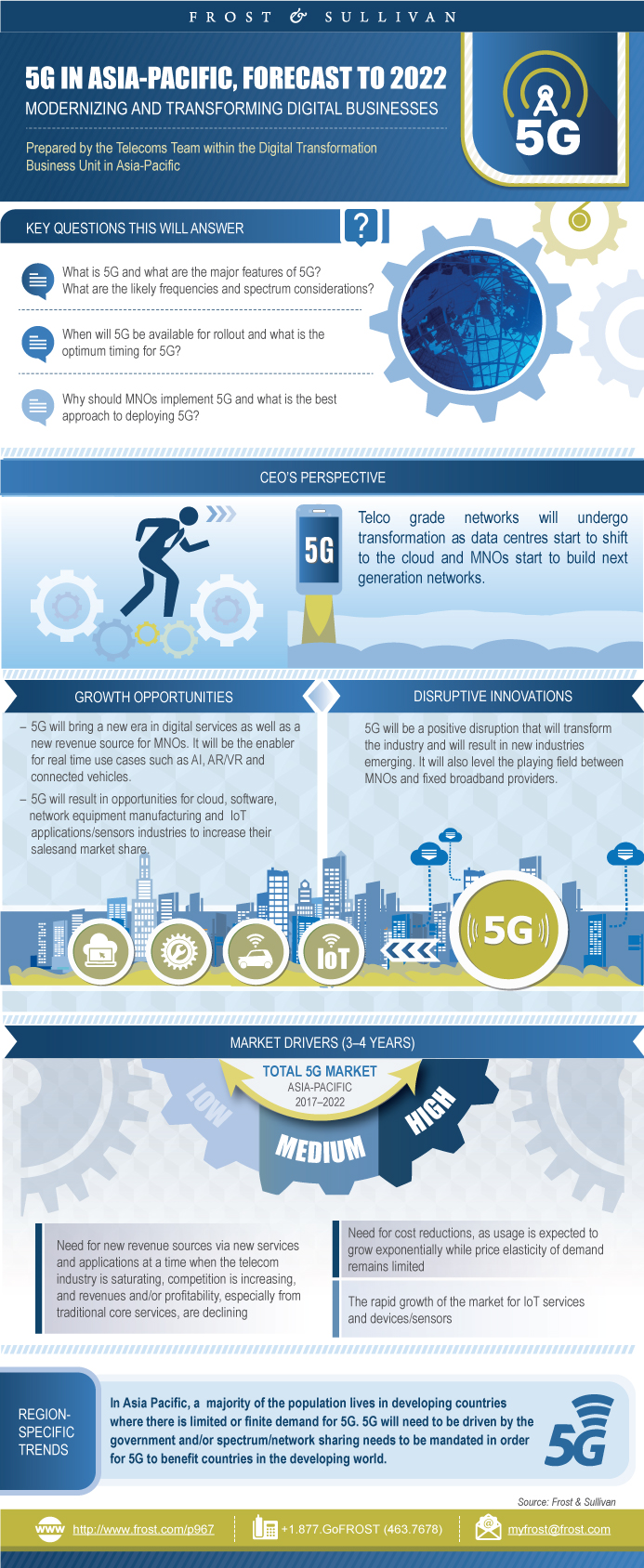Telecom
Growing Internet ubiquity across the world has resulted in endless possibilities for businesses and consumers. Connected living has become a reality. There will be at least 80 billion connected devices by 2020; and 10 connected devices for each household. The size of the Internet economy will reach $14.7 trillion; the digital economy will be augmented by IoT.
In this backdrop, the telecom industry is facing increasing competition, market saturation, and commoditization of technology-- challenging telcos to differentiate themselves with innovative services and applications. The rise in technological savviness in consumers and increasingly sophisticated technologies reaching masses has led to intra-industry and cross industry competition across several segments of the telecommunications sector to provide more end-to-end solutions.
Frost & Sullivan’s Telecommunications research and consulting programs look evolutions of hardware and software, with focus on the services built on these technologies. This provides unique insights into the competitive dynamics of the market, detailed assessments of market opportunities, pricing strategies, demand trends, and technological developments, as well as applications and best practices for the industry.
We work closely with the world’s leading telecom firms, hardware manufacturers, service providers, OEMs and new age disruptors to build tailored, customized solutions provide clients with the best strategies for growth, supported by the right key data points researched to meet the client’s needs and the specific engagement. Our research spans broadly across the sector and provides deep insights into specific markets in the most significant areas of enterprise and consumer telecommunications industry.
-
12 Dec 2017 | Asia Pacific
Data Center Standards
Best Practices in Defining Government Data Center Standards
Data Centers industry is more than 20 years old and over the years data center has become complex to operate. It has become quite challenging for data center operators to run their data center efficiently. The whole Asia Pacific is getting on the bandwagon of getting digitized and local governments have introduced many initiatives that would accele...
$1,500.00 -
15 Nov 2017 | Asia Pacific
2017 Cambodia Mobile Services Market Tracker
Historical and Forecast Data
Cambodia mobile penetration grew from 92.1% in 2011 to 133.5% in 2016. During the forecast period, mobile penetration is expected to grow marginally to reach 140.5%; and the mobile subscribers will grow to 24.2 million. The tracker provides details of the Cambodia mobile service providers and offers detailed historical & forecast data for the perio...
$1,500.00 -
15 Nov 2017 | Asia Pacific
2017 Indonesia Mobile Services Market Tracker
Historical and Forecast Data
Indonesia’s mobile penetration grew from 115.1% in 2011 to 150.0% in 2016. By 2021, mobile penetration is expected to reach 153.4%, with 420.9 million mobile subscribers. The market is predominantly prepaid with 98.3% of subscribers utilizing prepaid services from Indonesian mobile service providers. Prepaid ARPU is low and is expected to remain ...
$1,500.00 -
Malaysian mobile market is a matured one and has experienced a strong change in the consumption behaviour over the last five years. The market is primarily dominated by the three leading service providers and has a long list of MVNOs. Over the past couple of years, the country’s subscriber base remained stable around 44 million and mobile penetra...
$1,500.00 -
Nepal mobile market has experienced a strong growth over the past few years and the two leading service providers together control almost 95% of the total subscriber base. Over the past couple of years, the country's mobile penetration rapidly increased from under 71% in 2013 to 110% in 2016, surpassing the total population of 29 million. By 2021, ...
$1,500.00 -
08 Nov 2017 | Asia Pacific
Malaysia Mobile Services Market Tracker - 2017
Historical and Forecast Data
Although Malaysia’s mobile penetration grew from 134.5% in 2011 to 143.7% in 2016, mobile penetration has been on a decline since 2014 as a result of the introduction of GST in 2015. By 2021, mobile penetration is expected to have dropped to 135.6% with mobile subscribers amounting to 44.8 million subscribers. The market is still predominantly pr...
$1,500.00 -
31 Oct 2017 | Asia Pacific
Malaysian Mobile Services Market, 2016
Shifting Industry Dynamics Supporting Growth of Smaller Participants at the Expense of Incumbent Companies
Malaysia had 44.6 million mobile service subscriptions with a penetration rate of 143.7% in 2016. Mobile penetration has been on a decline since 2014 as a result of the introduction of GST in 2015. The mobile services market is highly prepaid in nature with 77.1% prepaid. Postpaid subscriptions have been increasing as a result of more competitive b...
$1,500.00 -
20 Jul 2017 | Asia Pacific
5G in Asia-Pacific, Forecast to 2022
Modernizing and Transforming Digital Businesses
5G is on its way. It may be closer to 2019-2020 for some but for others, it may be 2023-2025 before it materializes. In all the countries that are frontrunners of 5G in Asia-Pacific, 5G is benefiting from local government support coupled with local demand or at least the potential for demand for 5G services. The demand may be incentive or market dr...
$4,950.00
 USD
USD GBP
GBP CNY
CNY EUR
EUR INR
INR JPY
JPY MYR
MYR ZAR
ZAR KRW
KRW THB
THB
